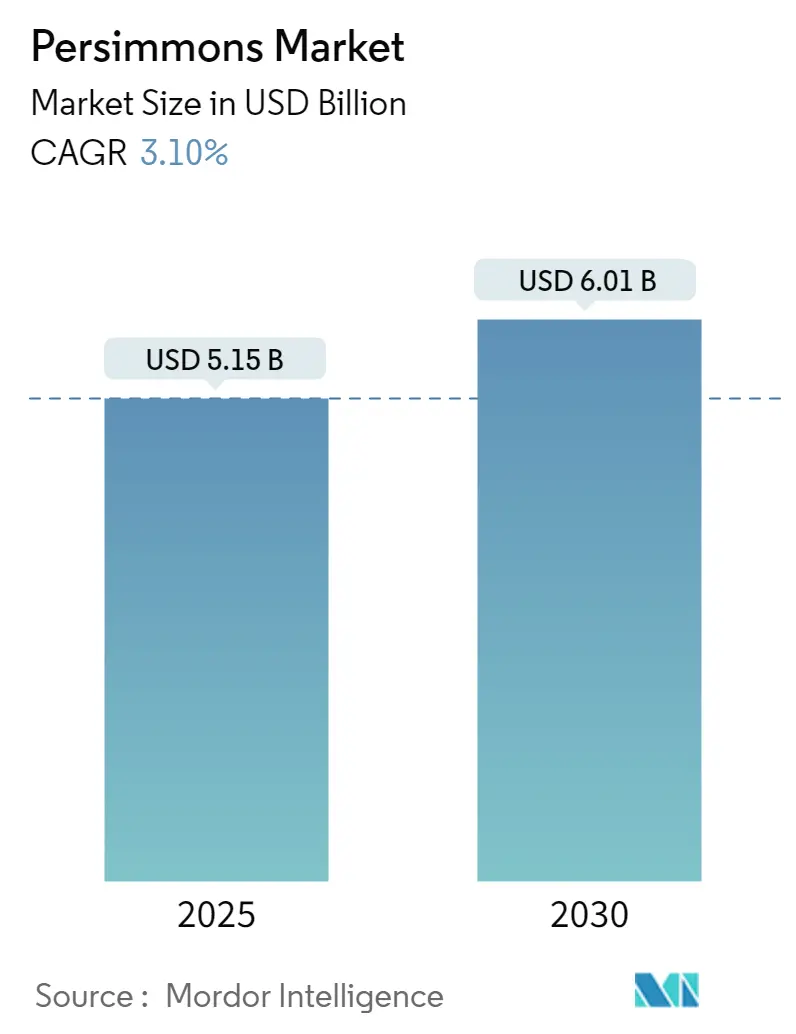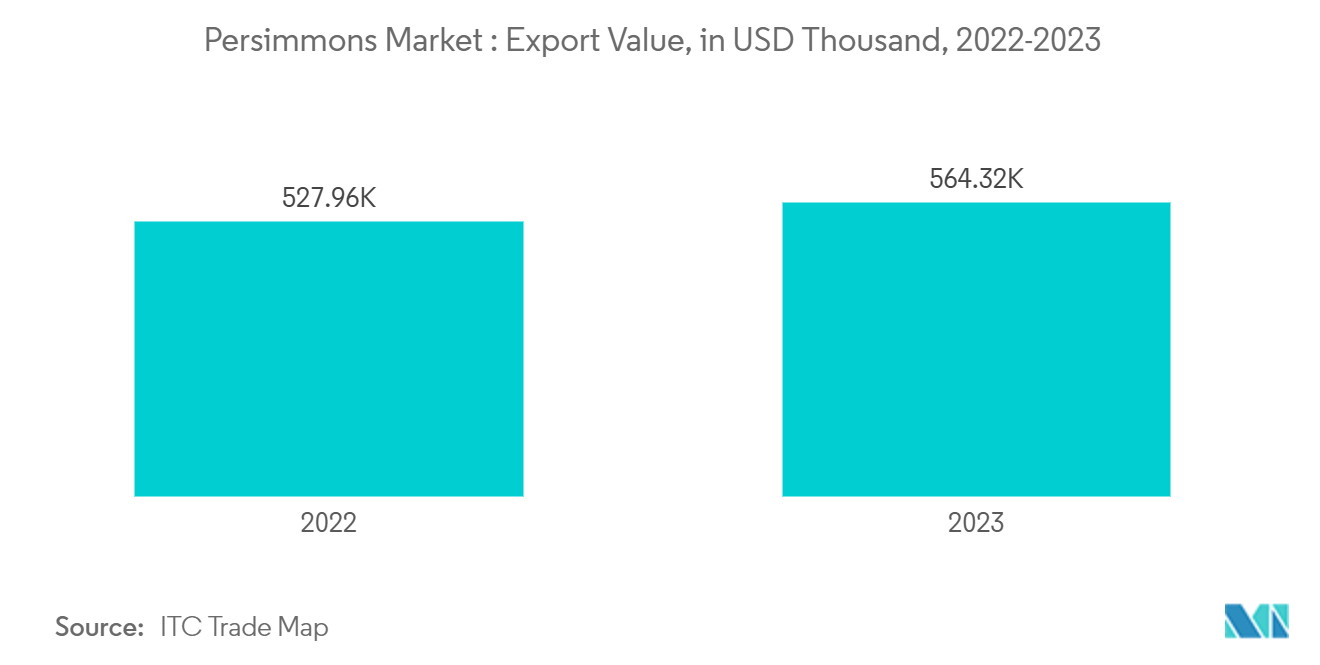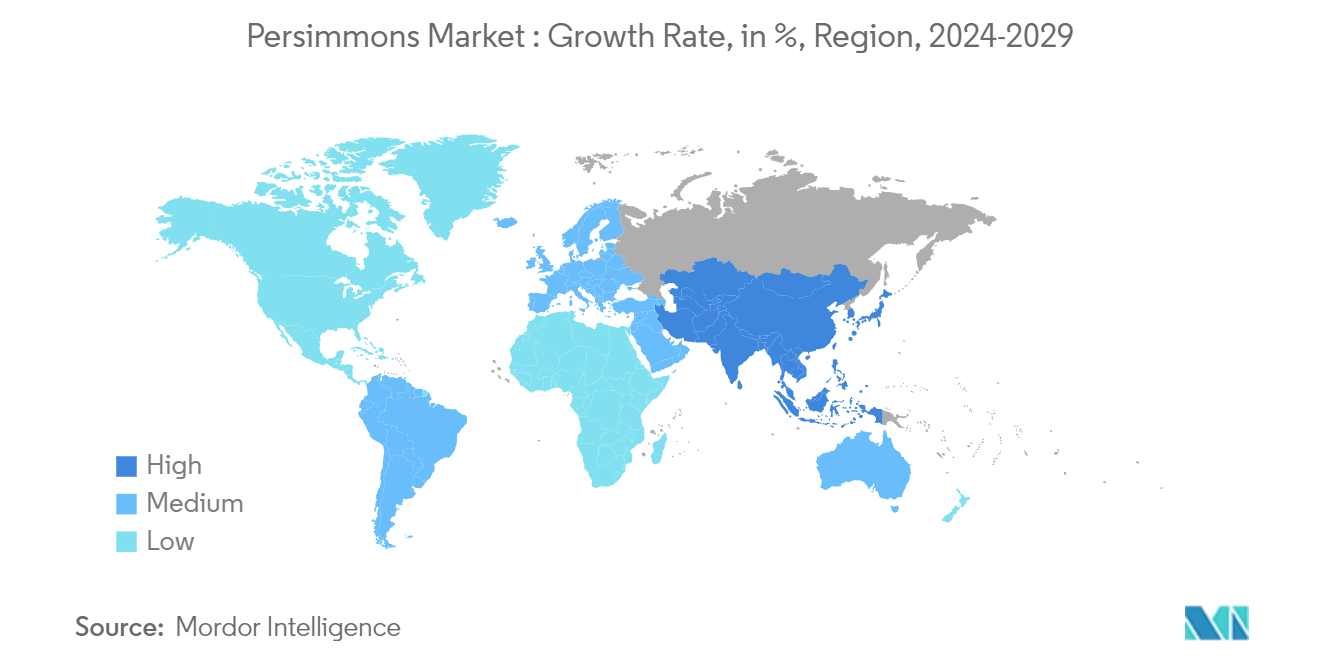Persimmons Market Size and Share

Persimmons Market Analysis by Mordor Intelligence
The Persimmons Market size is estimated at USD 5.15 billion in 2025, and is expected to reach USD 6.01 billion by 2030, at a CAGR of 3.1% during the forecast period (2025-2030).
The persimmon market is experiencing growth primarily due to increasing demand, driven by the fruit's nutritional value and export potential. Persimmons are rich in Vitamins A, C, and K, and possess antioxidant properties that improve insulin sensitivity and reduce oxidative stress. The fruit's versatility allows for its use in various products, including baked goods, custards, ice creams, preserves, puddings, and pulp.
Persimmon leaves are also utilized in herbal teas. The fruit's health benefits extend to weight management and immune system support. Drying is a significant processing technique that both preserves the fruit and increases its market value. This versatility, particularly in dried form, presents substantial growth opportunities for the market.
Data from the Food and Agriculture Organization (FAO) highlights that in 2022, China, South Korea, Japan, Azerbaijan, and Brazil emerged as the top global producers of persimmons. China led the product with a staggering 3,470.4 thousand metric tons, followed by South Korea at 231.5 thousand metric tons, Japan with 216.1 thousand metric tons, Azerbaijan at 184.3 thousand metric tons, and Brazil rounding off with 164.4 thousand metric tons.
Global Persimmons Market Trends and Insights
High Export Value Drives the Market
The export value of persimmons reached USD 564.3 million in 2023, marking a 6.9% increase from 2022. This growth is attributed to increased demand for persimmons due to their high nutritional content and bioactive compounds, which offer health benefits such as antioxidant and antidiabetic properties.
In 2023, the five largest exporters of persimmons - Spain, Azerbaijan, China, United States, and Uzbekistan - accounted for 85.1% of the total export value. This concentration is primarily due to high persimmon prices in importing countries and limited production in most regions. Countries with high demand but low or no production, such as Germany and the United States, import from major producers like China. China holds a notable position as both a leading exporter and consumer.
European countries led global persimmon exports in 2023, with shipments valued at USD 290.8 million, representing 51.5% of the global total. Asian suppliers followed closely, accounting for 44.47% of exports. The global increase in persimmon exports can be attributed to growing awareness and demand in international markets. Consumers are increasingly attracted to persimmons for their sweet taste, nutritional benefits, and culinary versatility. The rising interest in exotic fruits has also contributed to this growth trend.

Asia-Pacific Leads Global Persimmon Production
- Asia-Pacific dominates global persimmon fruit production. In this region, persimmons are highly valued in local markets for their taste and health benefits. Export demand from countries like Japan, South Korea, and China continues to grow, with persimmons being shipped worldwide. In 2022, China, South Korea, and Japan were the top producers, with outputs of 3,396.3 thousand metric tons, 231.5 thousand metric tons, and 216.1 thousand metric tons, respectively.
- China, the world's largest producer of persimmons, significantly contributes to the region's overall production. The country has experienced increases in both cultivation area and yield per hectare due to improved farming practices and investments. While maintaining stable acreage, China's persimmon production continues to rise, with dried persimmons emerging as the primary export product. Advancements in cultivation techniques and post-harvest handling have enhanced persimmon quality and shelf life, improving export potential.

Recent Industry Developments
- July 2024: The General Administration of Customs of China has announced that fresh persimmons from Tajikistan will be permitted for import into China. This market access is subject to the persimmons meeting specified phytosanitary requirements.
- January 2023: The European Commission's new Common Agricultural Policy introduced an initiative to assist European farmers in transitioning to a more sustainable and resilient agricultural sector, while preserving the diversity of rural communities. These strategic plans support rural persimmon growers in enhancing their production methods.
- February 2022: The Chinese government has proposed a strategy to enhance agricultural and rural development. It aims to achieve significant progress in rural agriculture through technological support for modern farming practices, including persimmon cultivation.
Global Persimmons Market Report Scope
Persimmon is an edible fruit, specifically a berry, produced by trees in the genus Diospyros. This versatile fruit can be consumed fresh, dried, or cooked. Persimmons are widely used globally in various culinary applications, including jellies, beverages, pies, curries, and puddings.
The persimmons market is segmented based on geography into North America, Europe, Asia-Pacific, South America, and Middle-East and Africa. The report offers an analysis of production (volume), consumption (value and volume), import (value and volume), export (value and volume), and price trend analysis.
The report offers market size and forecasts in terms of value (USD) and volume (metric tons) for all the above segments.
| North America | United States | Production Analysis |
| Consumption Analysis and Market Value | ||
| Import Market Analysis (Volume and Value) | ||
| Export Market Analysis (Volume and Value) | ||
| Price Trend Analysis | ||
| Canada | Production Analysis | |
| Consumption Analysis and Market Value | ||
| Import Market Analysis (Volume and Value) | ||
| Export Market Analysis (Volume and Value) | ||
| Price Trend Analysis | ||
| Mexico | Production Analysis | |
| Consumption Analysis and Market Value | ||
| Import Market Analysis (Volume and Value) | ||
| Export Market Analysis (Volume and Value) | ||
| Price Trend Analysis | ||
| Europe | Spain | Production Analysis |
| Consumption Analysis and Market Value | ||
| Import Market Analysis (Volume and Value) | ||
| Export Market Analysis (Volume and Value) | ||
| Price Trend Analysis | ||
| Italy | Production Analysis | |
| Consumption Analysis and Market Value | ||
| Import Market Analysis (Volume and Value) | ||
| Export Market Analysis (Volume and Value) | ||
| Price Trend Analysis | ||
| Asia-Pacific | China | Production Analysis |
| Consumption Analysis and Market Value | ||
| Import Market Analysis (Volume and Value) | ||
| Export Market Analysis (Volume and Value) | ||
| Price Trend Analysis | ||
| Japan | Production Analysis | |
| Consumption Analysis and Market Value | ||
| Import Market Analysis (Volume and Value) | ||
| Export Market Analysis (Volume and Value) | ||
| Price Trend Analysis | ||
| South Korea | Production Analysis | |
| Consumption Analysis and Market Value | ||
| Import Market Analysis (Volume and Value) | ||
| Export Market Analysis (Volume and Value) | ||
| Price Trend Analysis | ||
| South America | Brazil | Production Analysis |
| Consumption Analysis and Market Value | ||
| Import Market Analysis (Volume and Value) | ||
| Export Market Analysis (Volume and Value) | ||
| Price Trend Analysis | ||
| Chile | Production Analysis | |
| Consumption Analysis and Market Value | ||
| Import Market Analysis (Volume and Value) | ||
| Export Market Analysis (Volume and Value) | ||
| Price Trend Analysis | ||
| Middle-East and Africa | Israel | Production Analysis |
| Consumption Analysis and Market Value | ||
| Import Market Analysis (Volume and Value) | ||
| Export Market Analysis (Volume and Value) | ||
| Price Trend Analysis | ||
| Iran | Production Analysis | |
| Consumption Analysis and Market Value | ||
| Import Market Analysis (Volume and Value) | ||
| Export Market Analysis (Volume and Value) | ||
| Price Trend Analysis | ||
| Geography | North America | United States | Production Analysis |
| Consumption Analysis and Market Value | |||
| Import Market Analysis (Volume and Value) | |||
| Export Market Analysis (Volume and Value) | |||
| Price Trend Analysis | |||
| Canada | Production Analysis | ||
| Consumption Analysis and Market Value | |||
| Import Market Analysis (Volume and Value) | |||
| Export Market Analysis (Volume and Value) | |||
| Price Trend Analysis | |||
| Mexico | Production Analysis | ||
| Consumption Analysis and Market Value | |||
| Import Market Analysis (Volume and Value) | |||
| Export Market Analysis (Volume and Value) | |||
| Price Trend Analysis | |||
| Europe | Spain | Production Analysis | |
| Consumption Analysis and Market Value | |||
| Import Market Analysis (Volume and Value) | |||
| Export Market Analysis (Volume and Value) | |||
| Price Trend Analysis | |||
| Italy | Production Analysis | ||
| Consumption Analysis and Market Value | |||
| Import Market Analysis (Volume and Value) | |||
| Export Market Analysis (Volume and Value) | |||
| Price Trend Analysis | |||
| Asia-Pacific | China | Production Analysis | |
| Consumption Analysis and Market Value | |||
| Import Market Analysis (Volume and Value) | |||
| Export Market Analysis (Volume and Value) | |||
| Price Trend Analysis | |||
| Japan | Production Analysis | ||
| Consumption Analysis and Market Value | |||
| Import Market Analysis (Volume and Value) | |||
| Export Market Analysis (Volume and Value) | |||
| Price Trend Analysis | |||
| South Korea | Production Analysis | ||
| Consumption Analysis and Market Value | |||
| Import Market Analysis (Volume and Value) | |||
| Export Market Analysis (Volume and Value) | |||
| Price Trend Analysis | |||
| South America | Brazil | Production Analysis | |
| Consumption Analysis and Market Value | |||
| Import Market Analysis (Volume and Value) | |||
| Export Market Analysis (Volume and Value) | |||
| Price Trend Analysis | |||
| Chile | Production Analysis | ||
| Consumption Analysis and Market Value | |||
| Import Market Analysis (Volume and Value) | |||
| Export Market Analysis (Volume and Value) | |||
| Price Trend Analysis | |||
| Middle-East and Africa | Israel | Production Analysis | |
| Consumption Analysis and Market Value | |||
| Import Market Analysis (Volume and Value) | |||
| Export Market Analysis (Volume and Value) | |||
| Price Trend Analysis | |||
| Iran | Production Analysis | ||
| Consumption Analysis and Market Value | |||
| Import Market Analysis (Volume and Value) | |||
| Export Market Analysis (Volume and Value) | |||
| Price Trend Analysis | |||
Key Questions Answered in the Report
How big is the Persimmons Market?
The Persimmons Market size is expected to reach USD 5.15 billion in 2025 and grow at a CAGR of 3.10% to reach USD 6.01 billion by 2030.
What is the current Persimmons Market size?
In 2025, the Persimmons Market size is expected to reach USD 5.15 billion.
Which is the fastest growing region in Persimmons Market?
Europe is estimated to grow at the highest CAGR over the forecast period (2025-2030).
Which region has the biggest share in Persimmons Market?
In 2025, the Asia accounts for the largest market share in Persimmons Market.
What years does this Persimmons Market cover, and what was the market size in 2024?
In 2024, the Persimmons Market size was estimated at USD 4.99 billion. The report covers the Persimmons Market historical market size for years: 2019, 2020, 2021, 2022, 2023 and 2024. The report also forecasts the Persimmons Market size for years: 2025, 2026, 2027, 2028, 2029 and 2030.
Page last updated on:
Persimmons Market Report
Statistics for the 2025 Persimmons market share, size and revenue growth rate, created by Mordor Intelligence™ Industry Reports. Persimmons analysis includes a market forecast outlook for 2025 to 2030 and historical overview. Get a sample of this industry analysis as a free report PDF download.

